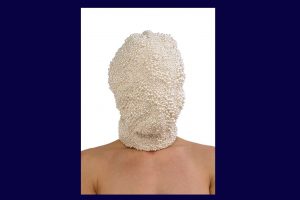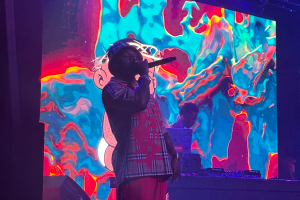Symposium unpacks art world’s 2021 buzzword: Deaccessioning
Symposium unpacks art world's 2021 buzzword: Deaccessioning
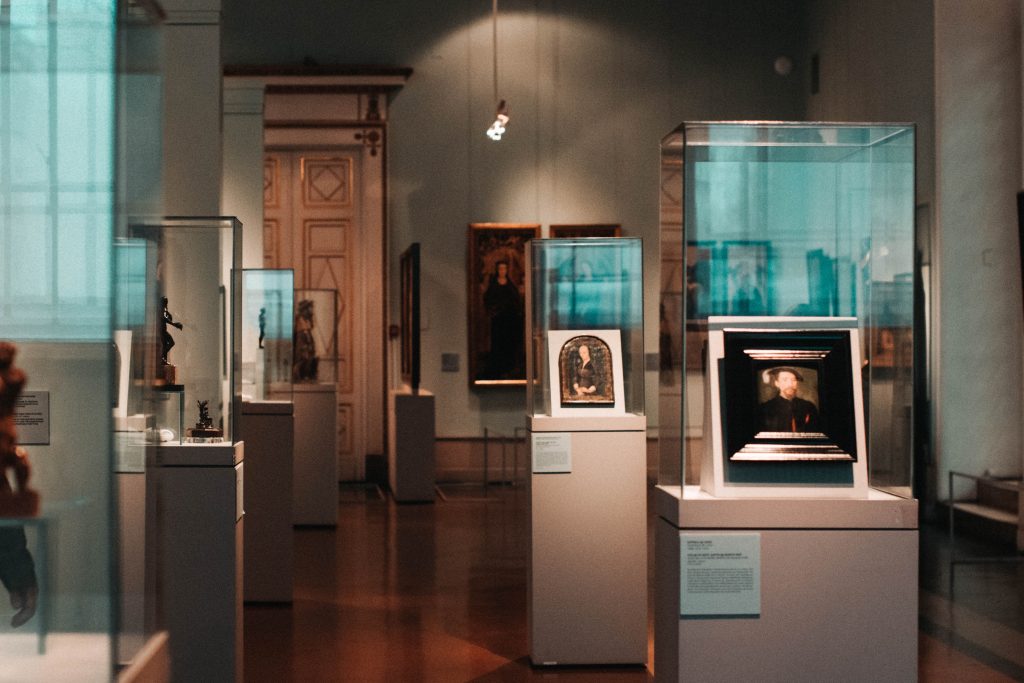
There has never been a greater demand for more inclusive practices in the arts in light of recent circumstances. With social justice movements happening all over the world, marginalized people have been fighting for their voices to be heard in all facets of life, and people of color are paving ways for necessary change. During her opening keynote address at the Deaqusisioning After 2020 Symposium put on by the Graduate Program in Museum Studies and the College of Law, Stephanie Johnson-Cunningham, co-founder of Museum Hue — an organization that aims to highlight minority artists and their art — advocated for diversifying historically exclusive institutions.
In a conversation with Andrew Saluti, museum studies program coordinator at Syracuse University’s College of Visual and Performing Arts, Johnson-Cunningham described her work with Museum Hue as aiming to be more inclusive and to accurately reflect the society it represents. She said it starts with the institutional power structures at play in deciding which works are represented and aims to challenge the canon which has historically been exclusive of people of color.
“To be honest, there are a lot of people struggling to bring the issue of race to the forefront of their museums,” Johnson-Cunningham said. “But some of these same museums are deaccessioning and disposing of work to then acquire works by Black artists, people of color and women without addressing this real underlying issue of racial inequity within these entities, first and foremost.”
An issue lies in works by artists of color being collected and displayed more, which sounds like a catalyst for progressive change, but the research that needs to be done on the curatorial side is still severely lacking. For example, Johnson-Cunningham said African-American art has been over-exhibited but under-theorized, creating an “asymmetry.”
This is why collecting work is simply not enough. The solution to this issue requires more attention to racial inequity, and Johnson-Cunningham believes more inclusive narratives need to begin in the discipline of art history itself. In a society where Western and European art is canon, inclusivity lies in education—especially in academia.
The museum’s role is not “neutral” and in these massive institutions, specifically those in New York City that Johnson-Cunningham has worked with personally, there is a diminished role of objects present in a museum as they exit through deaccessioning, sale and repatriation. Therefore, Johnson-Cunningham said the museum’s role goes beyond its collection.
“Another part of the field that is under-theorized is community-centered approaches over collection-centered approaches in museum practices,” Johnson-Cunningham said. “Culturally-specific museums are the leaders of community-centered rather than collection-centered approaches. Many provide the framework and thought leadership needed to shift narratives and interpretations and socializations of museums on all levels.”
Johnson-Cunningham believes that the answers to incentivize representation in museums can be found in different avenues such as academia, legal criteria, funding and the public’s interest. Change cannot solely occur in collections, but also in how the field is approached and understood through education.
Education of what it means for these institutions to be truly representative extends beyond the Western canon, and when asked how curriculum can be more inclusive for people of color wanting to enter this field, Johnson-Cunningham said it needs to focus on a wide range of issues including race, women’s issues and mental health.
“There are a lot of people who are attracted to Museum Hue based on the fact that we are saying that there needs to be more narratives in institutions, more ways in looking and seeing institutions,” Johnson-Cunningham said. “So I think as we begin to increase opportunities for students to learn about a range of different museums and different museum approaches, you’ll get more interest in the field and students wanting to be part of the museum field.”
Entitled “The Impermanence of Objects and Museums,” the third session examined how the deaccessioning discussions impact the idea of a permanent collection. Author and curator Stefanie S. Jandl moderated the conversation between Michael Conforti, director emeritus of the Clark Art Institute, Steven Lubar, a professor of American Studies at Brown University, and Amy Whitaker, a current assistant professor at NYU who has worked in the art world for many years.
The conversation between these three explicitly built onto points made in earlier sessions, helping to give the virtual symposium more of a thread of continuity.
Lubar opened the conversation with his thoughts on what art museums could learn from history and anthropology museums – usefulness, community and collections growth. He also discussed what can be learned from art museums that have failed, citing The Jenks Museum at Brown.
Conforti raised the point that unlike many other countries, the U.S. has no cultural ministry, meaning there is no overarching governing body for art museums to lean on. His view is that the necessity of a permanent collection varies from museum to museum. Encyclopedic museums, such as the Smithsonian Institution or the Victoria and Albert Museum, should not be allowed to deaccession items, but places like the Walker Art Center, the Albright-Knox Art Gallery, and The Guggenheim should be able to.
Building on this, Whitaker explained her theory about “the good death of an object,” an idea further explored in a paper she wrote for the book “Collections and Deaccessioning in a Post Pandemic World.”
Guiding the second half of the session was a more overt conversation about finances. Whitaker described the change in the AAMD rule as changing the transaction of deaccessioning from art in exchange for new art, to art in exchange for tangible money. During this conversation, Conforti also brought up the idea of a cultural dissatisfaction with the storage of art versus its display.
Questions surrounding whether these actions would lead to the death of the museum were also addressed. Conforti made a macabre joke about how if these actions will lead to that, at least he will not be alive to see it.
Later on, Lubar brought up the idea of a more robust loan network as a deaccessioning method that is less permanent. He referenced the Houston Museum’s plan to bring parts of their collections into schools and hospitals, which extends the idea of loaning outside the world of art museums and into a more extensive cultural network.
Both Whitaker and Conforti expressed their desire to see this happen, but cited the economic difficulties of collaborations and the lack of leadership from larger institutions as potential pitfalls.
This segued into a couple of audience questions, the first of which explored the idea of co-ownership between museums. Whitaker described this as the “it takes a village method” and described a current contract between an artist and a gallery that she helped broker.
The final ideas explored in the session were how blockchain might provide verification and historicism while removing colonial institutions in the deaccessioning or loaning process. Additionally, the panel discussed that the concept of collections as capital is coming into play because it is not strictly against AAMD guidelines, although many frown upon it.
The role of museum institutions championing diversity came into question yet again this afternoon as the Deaccessioning After 2020 symposium continued. A panel of artists including Meleko Mokgosi, Amalia Mesa-Bains, Deborah Kass and Wendy Red Star discussed the work in context with museum practices, which have often excluded anyone who is not a white male.
Syracuse University artist in residence Carrie Mae Weems moderated the discussion and topics such as white male dominated collections and hope for diversity in curatorial staff came up. Amalia Mesa-Bains, whose work focuses primarily on Chicano alters, said she has seen the same practices in institutional settings for decades, and that although there are greater pushes for diversity, not much change has actually been made.
“I came to the realization that the entire structure of the museum is a flawed one, and I’m not sure we can rectify it,” Mesa-Bains said. “…I think it’s [museums] rotten from the inside out.”
Mesa-Bains went on to say that financial investments in large white collections are almost impossible to “deconstruct.” However, she believes that her work is vital to her community which she wants to represent, and other panelists such as Wendy Red Star agreed that they want their work to be understood in the context of empathy and connection on a human level.
Meleko Mokgosi, artist and associate professor at the Yale School of Art, said the field of art is dominated by Anglo-European forms of thinking, and discourse is at the center of how we view these institutions. He said discourse is bound by rules, proving that it is exclusionary and not everyone is invited to the conversation, hence the need for an “unconditionally shared space.”
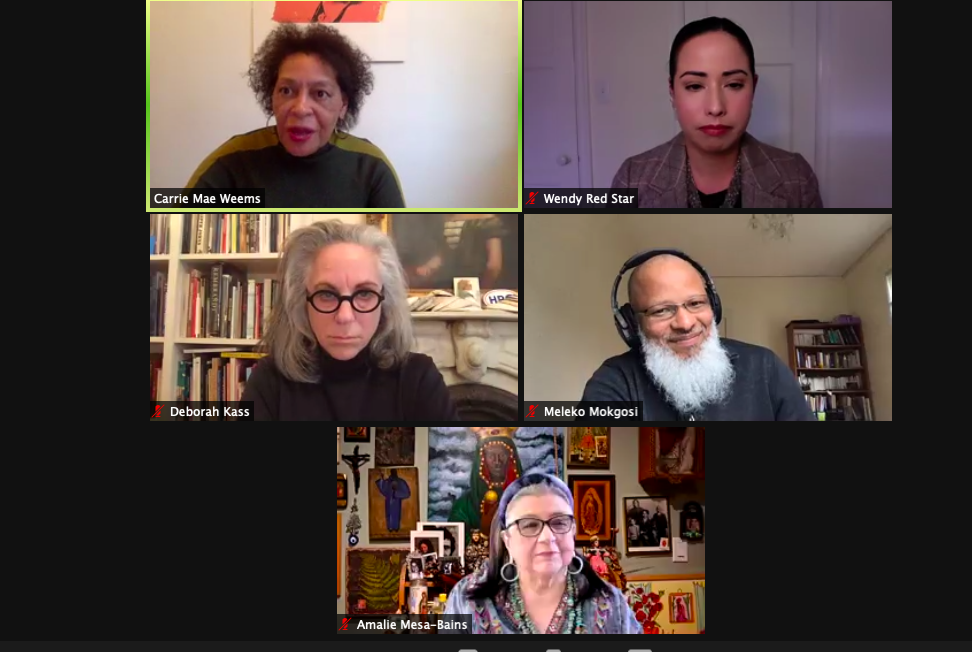
“The field of art is not a shared space,” Mokgosi said. “Who it represents is biased. In order to make it a shared space, or an unbiased space… there would need to be a whole scale relinquishing of power and capital.”
Artist Deborah Kass recounted her own experience as an emerging artist in the 1980s, and said as white men made the money in the arts, museums followed it as they could not get enough of “male whiteness.” According to her perspective, however, this was a time where women were doing important work, including the panel’s own Carrie Mae Weems. White male authority was being challenged in different spaces, except for painting, leading Kass to create a series in 1989 called “The Art History Paintings,” a response to the lack of women in the field.
“Over the next 30 plus years, I explored a range of strategies and styles to ask, ‘Where do I see my reflection? How do I paint my presence into a language that has excluded me?’” Kass said.
Mesa-Bains also went on to say that aside from deaccessioning, a problem lies in the fact that curators of color are often not present, as well as feminists. She said with deaccessioning, depth of knowledge and community engagement is not there.
For artists of color working in this field, Weems said diversity is an integral part of life, and the lack of it is not an issue in terms of the artists doing crucial work. She said they’re the catalyst for change and innovation, and fault comes from the leadership of these institutions who are being challenged.
“The question of diversity only really comes up when your world is not diverse,” Weems said.
There is no discussion about deaccessioning without talking about the Baltimore Museum of Art and its director Christopher Bedford. Bedford and the BMA have put forth two deaccessioning plans in the past four years. Rather than shying away from discussing the controversy that surrounded these decisions, Bedford embraced it, citing his experiences as a case study during his keynote address.
“There is little doubt that deaccessioning has become the most hotly contested subject in the art world,” opened Bedford. “Why shouldn’t we sell art to achieve these most pressing and indeed laudable goals?”
In 2018, the BMA sold seven works for $7 million, intending to add pieces by women and artists of color to their collection. Since then, they have been able to use that money to purchase 95 works by 82 different artists, including Amy Sherald and Carrie Mae Weems.
In 2020, the BMA tried to do this again with three paintings for $65 million. Plans for this money included pay equity and breaking down community barriers as well as purchasing new acquisitions. But art critics, former AAMD members and the public attacked their plan. The sale was stopped hours before the pieces went to auction.
Bedford stated he was not trying to re-litigate this sale in the keynote but to use it as an example that the art world may be entering a phase where it should challenge the AAMD guidelines and institutional norms. Arguing that fighting against the way museums have continuously operated is the only way to achieve equity and diversity, he explained.
“Equality is achieved in the future by reckoning with one’s past in the present and moving with speed and determination to address the biases of that part,” said Bedford. “I do not believe this process can be achieved through a methodology of pure addition.”
During the last portion of his speech, he touched on one of the central questions dividing the deaccessioning discussion: who, or what, does a museum serve? Bedford and the BMA believe a museum does not serve the objects and instead must utilize these objects to serve the individuals in their community.
Building on this, Bedford clarifies that the shutdown of their attempted 2020 deaccessioning would not impede the BMA work in diversity and equality. They were able to launch some of the intended programs with a generation donation.
He also called for changes in art history education beginning with the textbooks. Art Since 1960 is a commonly used contemporary art history book, and yet, as Bedford highlights, only 24 of the 800 (about 3%) artists mentioned are artists of color. The book was published in 2004.
“The real threat to museums is not deaccessioning, but continuing to lose relevance because we are not responding to this moment, our moment, in history and embracing our communities properly,” Bedford said in closing.
As the Syracuse Symposium has demonstrated over the past two days, the debate around deaccessioning is nuanced and complex. This complexity carried on in the final session: a conversation between five unique perspectives in the art world around the topic of change.
While all panelists supported the act of deaccessioning, there was much debate around what these funds should be used for. Thomas Campbell, director and CEO of the Fine Arts Museums of San Francisco, believes museums should only use money from deaccessioning for acquisitions. On the other side was Christopher Bedford, director of The Baltimore Museum of Art and keynote speaker at the symposium. He had a failed deaccessioning plan last year where the funds were meant to go to a wide variety of things, including raises, education and acquisitions.
“Once you have a mission that is larger than the objects, then you have to look at how you’re going to be able to do that,” said Tracy Riese, Trustee and Chair of Collections Committee at the Brooklyn Museum and supporter of a mission-based spending approach. “If someone were to tell me that by selling a Warhol, I might be able to endow an educational program or put it to a community engagement program, I would consider that an extremely valuable investment.”
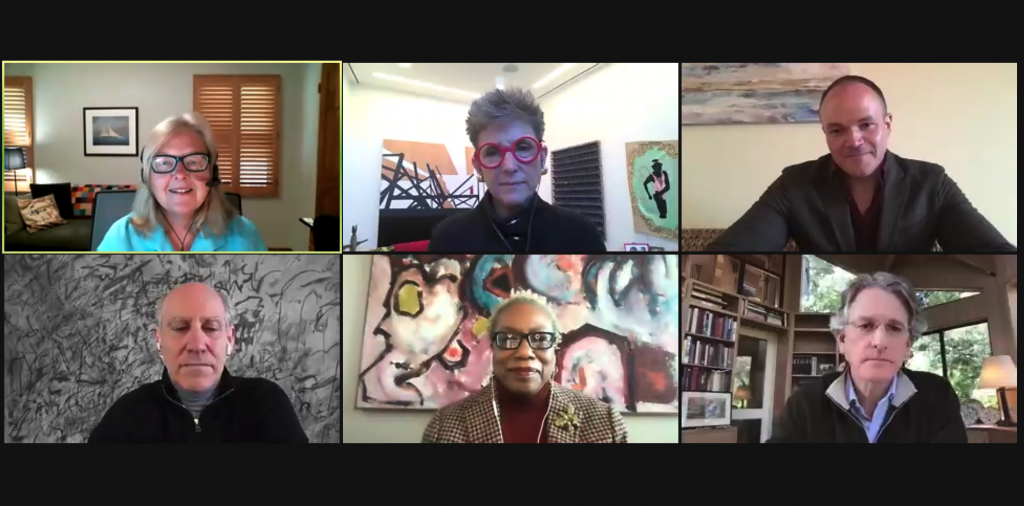
Linda Harrison, director and CEO of The Newark Museum of Art, put forth her desire for a governing body like AAM or AAMD to create a specific policy that all museums would have to abide by. Harrison is a member of the latter.
“The time to have this conversation, and to make it an open and robust debate, is when you’re out of the crisis, when you can begin to ask these big questions,” said Glenn D. Lowry, the director of The Museum of Modern Art.
Bedford explained that the institution of the art museum may not be able to wait that long if artists and others are already vulnerable and losing faith, citing his sessions over the course of two days as evidence.
“You almost never get meaningful change unless you’re responding to a crisis,” responded Riese. “We could be having this conversation in the abstract for dozens of years if we haven’t already.”
The final panel echoed themes from the entire symposium. It continued to illuminate the idea that deaccessioning is a pressing issue but is also just the beginning of a renaissance of art museums’ ideals and practices.
“I think deaccessioning is one part of a toolkit we can apply towards achieving a relevant, equitable, accessible, just, justice-based museum. Which is what we’re all talking about,” said Bedford in closing remarks.



